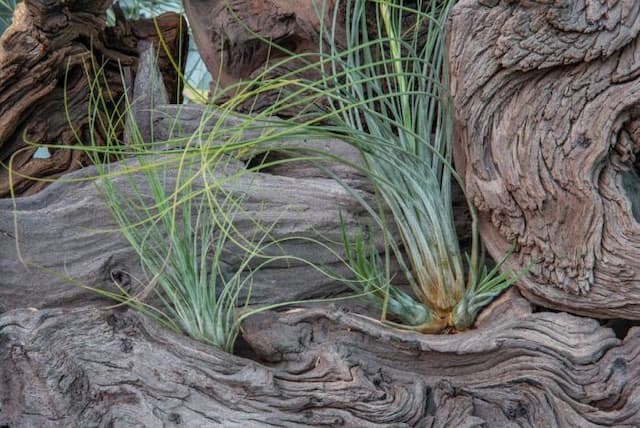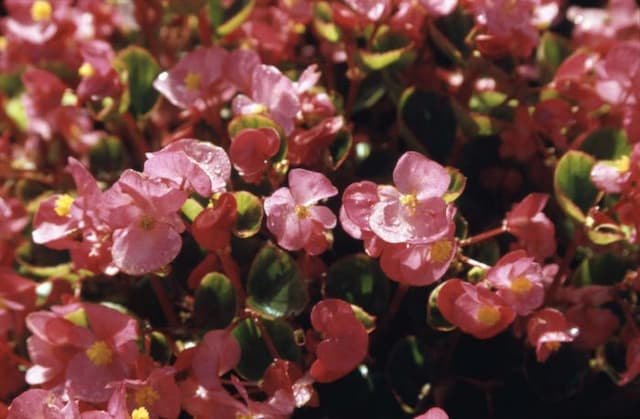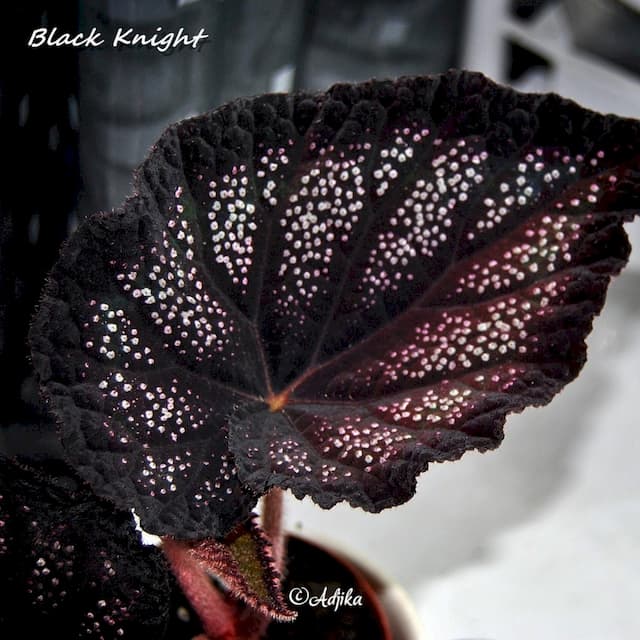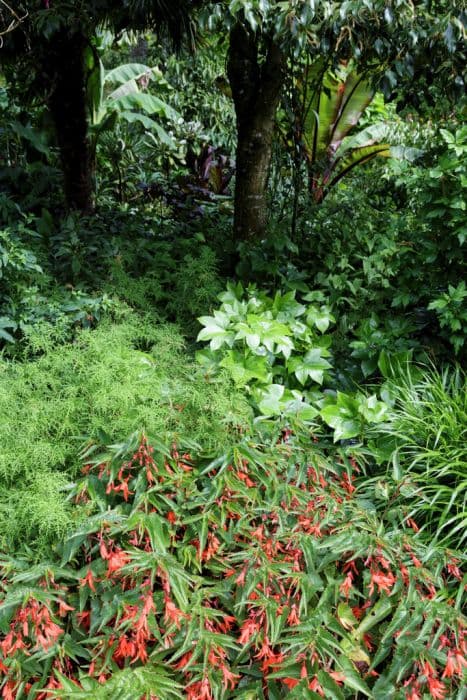Angel Wing Begonia Begonia 'Lucerna' (C)

ABOUT
Begonia 'Lucerna', commonly known as Angel Wing Begonia, is a strikingly beautiful houseplant. It boasts asymmetrical, pointed leaves that have a wing-like appearance, which is how it gets its common name. The leaves are lush and often large, with a glossy green surface that may have a red underside, giving it a two-toned quality. This foliage is typically decorated with metallic-looking silver dots and a distinct reddish-brown pattern that follows the veins. During its blooming period, Angel Wing Begonia produces clusters of drooping flowers that range in color from white to pink to red. These flowers add an extra layer of appeal to the plant, making it look quite elegant. The overall aesthetic of the Angel Wing Begonia is a combination of its ornamental leaves and the cascading flowers that can give a vibrant pop of color to indoor spaces.
About this plant
 Names
NamesFamily
Begoniaceae
Synonyms
Angel Wing Begonia, Dragon Wing Begonia
Common names
Begonia corallina 'Lucerna', Begonia corallina var. lucerna.
 Toxicity
ToxicityTo humans
The plant commonly known as Angel-wing Begonia is not considered highly toxic to humans. However, it can cause irritation in the mouth, throat, and may cause mild nausea if ingested. It is prudent to keep the plant out of reach of children who might chew on it.
To pets
Angel-wing Begonia is considered toxic to pets, particularly cats and dogs. If ingested, it can cause vomiting, salivation, and kidney failure. It is important to seek veterinary care if you suspect your pet has eaten any part of the plant.
 Characteristics
CharacteristicsLife cycle
Perennials
Foliage type
Evergreen
Color of leaves
Mixed
Flower color
Pink
Height
1-3 feet (0.3-0.9 meters)
Spread
1-3 feet (0.3-0.9 meters)
Plant type
Herb
Hardiness zones
10
Native area
Central America South America
Benefits
 General Benefits
General Benefits- Decorative Appeal: Begonia 'Lucerna' is known for its lush, attractive foliage and bold, colorful flowers, adding aesthetic beauty to indoor and outdoor spaces.
- Low Maintenance: It is relatively easy to care for, requiring only moderate watering and indirect light, making it suitable for gardeners of all levels.
- Improved Mood: Interacting with plants like the Begonia can improve mood, reduce stress, and enhance overall mental well-being.
- Humidity Control: Through transpiration, Begonia 'Lucerna' helps maintain healthy humidity levels indoors, which can be beneficial in dry climates or during winter months when indoor air tends to get dry.
- Temperature Regulation: Like many houseplants, Begonia 'Lucerna' can contribute to regulating indoor temperatures by absorbing heat, which can create a cooler environment in the immediate vicinity.
- Creates Habitat: When planted outdoors, the Begonia provides shelter and food for pollinators such as bees and butterflies, supporting local biodiversity.
- Education and Hobby: Growing Begonia 'Lucerna' can be an educational activity for both children and adults, fostering an interest in botany and horticulture.
 Medical Properties
Medical PropertiesThis plant is not used for medical purposes.
 Air-purifying Qualities
Air-purifying QualitiesThis plant is not specifically known for air purifying qualities.
 Other Uses
Other Uses- Begonia 'Lucerna' can be a source of inspiration for artists and designers due to its unique foliage and colorful flowers, often leading to patterns or motifs used in textiles and wallpapers.
- The plant can be used in educational settings such as schools and botanical workshops to teach about plant propagation and hybridization methods, given its ease of propagation from leaf cuttings.
- In cooler climates, Begonia 'Lucerna' serves as an indicator of seasonal change, as it requires being moved indoors to avoid frost, thus helping gardeners time their planting schedules.
- Begonia leaves, including those of 'Lucerna', are sometimes used in the crafting industry to make impressions in clay or plaster for decorative purposes.
- The plant's ability to thrive in shaded environments makes it an excellent addition to terrariums, creating miniature landscapes or fairy gardens.
- Begonias like 'Lucerna' can be used in container gardening as a way to bring color and variety to balconies and patios where ground space is limited.
- Due to its ornamental appeal, Begonia 'Lucerna' can be used as a living gift or token of appreciation for events like housewarmings or as gestures of friendship.
- The intricate patterns and vibrant colors found in 'Lucerna's' leaves and flowers can be utilized in photography to provide natural, lively backgrounds for portrait and macro photography.
- Begonia 'Lucerna' can play a role in horticultural therapy programs, providing a sensory and tactile experience for participants to encourage relaxation and well-being.
- Gardeners may use Begonia 'Lucerna' to create a contrast or highlight when planning a color-themed garden, with its vivid blooms standing out against green foliage.
Interesting Facts
 Feng Shui
Feng ShuiThe Angel Wing Begonia is not used in Feng Shui practice.
 Zodiac Sign Compitability
Zodiac Sign CompitabilityThe Angel Wing Begonia is not used in astrology practice.
 Plant Symbolism
Plant Symbolism- Caution - Begonias are often associated with caution or heedfulness. Their diverse and sometimes subtly colored foliage can serve as a reminder to be wary in new situations.
- Harmony - The balance in the begonia's growth pattern and its non-showy flowers may symbolize harmony and balance in life.
- Individuality - With its unique and varied leaf forms and colors, begonias can represent individuality and the importance of standing out from the crowd.
- Gratitude - Giving Begonia 'Lucerna' as a gift may be a way of expressing thanks, possibly due to its pleasing aesthetic and the effort required to care for the plant.
- Unconsciousness - In the language of flowers, a begonia can sometimes symbolize a state of unawareness, possibly drawing from the plant's understated appearance.
 Water
WaterAngel Wing Begonia should be watered regularly, aiming to keep the soil consistently moist but not soggy. Typically, watering once a week should suffice, though this can vary depending on environmental factors such as temperature and humidity. During the active growing season in spring and summer, you may need to water more frequently, approximately 16 ounces each week. Always check the top inch of the soil before watering; if it feels dry to the touch, it's time to water. Be careful not to let the plant sit in water as this can lead to root rot.
 Light
LightAngel Wing Begonia thrives best in bright, indirect light. A spot near a window that receives filtered sunlight or is lightly shaded by sheer curtains would be ideal. Avoid placing it in direct sunlight, especially during the harsh midday hours, as this can scorch the leaves and cause fading of the vibrant leaf patterns.
 Temperature
TemperatureThe Angel Wing Begonia prefers a warm climate and does best in temperatures ranging between 60 to 75 degrees Fahrenheit. It should not be exposed to temperatures below 50 degrees Fahrenheit as cold temperatures can cause damage to the plant. An ideal indoor location would maintain a consistent temperature within this range, away from drafts and sudden temperature changes.
 Pruning
PruningPruning your Angel Wing Begonia promotes bushier growth and prevents the plant from becoming leggy. Prune in the spring or early summer by trimming back long or overgrown stems, and remove any dead or yellowing leaves to encourage new growth. It is not typically necessary to prune more than once a year, unless you are trying to shape the plant or control its size.
 Cleaning
CleaningAs needed
 Soil
SoilAngel Wing Begonias like 'Lucerna' perform best in a well-draining soil mix composed of potting soil, peat moss, and perlite in equal parts. The optimum soil pH should be slightly acidic, ranging between 5.5 and 6.5.
 Repotting
RepottingAngel Wing Begonias like 'Lucerna' should typically be repotted every 1-2 years during the spring to accommodate their growth and refresh their soil.
 Humidity & Misting
Humidity & MistingAngel Wing Begonias like 'Lucerna' thrive with higher humidity levels, around 50-60%, which mimics their native tropical environment.
 Suitable locations
Suitable locationsIndoor
Place 'Lucerna' in bright, indirect light, and ensure high humidity.
Outdoor
Grow in partial shade, shelter from strong winds and direct sun.
Hardiness zone
10-11 USDA
 Life cycle
Life cycleThe life cycle of the Begonia 'Lucerna', commonly known as Angel Wing Begonia, begins with seed germination, where the tiny seeds develop in a warm, humid environment. After germination, seedlings emerge and slowly grow into young plants, developing their characteristic wing-shaped leaves and establishing a root system. As the plant matures, it enters a robust vegetative growth phase where it produces larger leaves and may be propagated by cuttings to produce new plants. Once mature, the Angel Wing Begonia enters its flowering stage, producing clusters of hanging flowers that can be red, pink, or white, typically blooming in warmer months when daylight hours are longer. After pollination, seeds are produced which can be collected for the next generation; however, many cultivators choose to propagate vegetatively for consistency. Finally, if environmental conditions are suboptimal or the plant experiences stress or disease, it may enter a dormancy phase or die back, potentially re-emerging from its tuber or rhizome if conditions improve.
 Propogation
PropogationPropogation time
Spring to Summer
Propogation: The best time to propagate Begonia 'Lucerna', commonly known as Angel Wing Begonia, is during the spring or early summer when the plant is actively growing. Among the various propagation methods, stem cuttings are the most popular due to their simplicity and effectiveness. To propagate through a stem cutting, choose a healthy stem with a few leaves on it and cut just below a node, ensuring the cutting is about 3 to 5 inches (about 7.5 to 12.5 centimeters) long. Remove the lower leaves and dip the cut end into rooting hormone powder to encourage root growth. Plant the cutting in a well-draining potting mix, water it, and then cover it with a plastic bag or place it in a propagator to maintain high humidity. Keep the soil consistently moist but not soggy, and in a few weeks, the cutting should develop roots and can be treated as a new plant.

![Begonia [Allure]](/_next/image?url=https%3A%2F%2Fplants-admin.emdemapps.com%2Fimages%2Fplants%2F%2Fimages%2F604b5b9006ab9.png&w=640&q=75)







